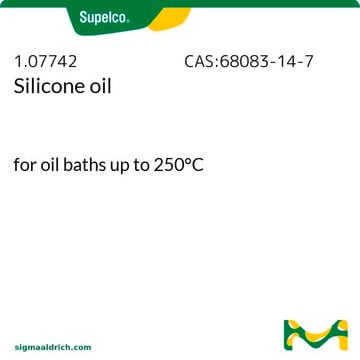All Photos(3)
About This Item
Linear Formula:
[-Si(CH3)2O-]n
CAS Number:
MDL number:
UNSPSC Code:
12162002
NACRES:
NA.23
Recommended Products
vapor density
>1 (vs air)
vapor pressure
<5 mmHg ( 25 °C)
5 mmHg ( 20 °C)
form
viscous liquid
refractive index
n20/D 1.403 (lit.)
viscosity
100,000 cSt(25 °C)
bp
>140 °C/0.002 mmHg (lit.)
density
0.971 g/mL at 25 °C
Looking for similar products? Visit Product Comparison Guide
Storage Class Code
10 - Combustible liquids
WGK
WGK 1
Flash Point(F)
214.0 °F - closed cup
Flash Point(C)
101.1 °C - closed cup
Personal Protective Equipment
dust mask type N95 (US), Eyeshields, Gloves
Choose from one of the most recent versions:
Already Own This Product?
Find documentation for the products that you have recently purchased in the Document Library.
Customers Also Viewed
Bo Xian et al.
Aging cell, 12(3), 398-409 (2013-02-28)
Caenorhabditis elegans is a leading model organism for studying the basic mechanisms of aging. Progress has been limited, however, by the lack of an automated system for quantitative analysis of longevity and mean lifespan. To address this barrier, we developed
Amir Sanati Nezhad et al.
Proceedings of the National Academy of Sciences of the United States of America, 110(20), 8093-8098 (2013-05-01)
Tip-growing cells have the unique property of invading living tissues and abiotic growth matrices. To do so, they exert significant penetrative forces. In plant and fungal cells, these forces are generated by the hydrostatic turgor pressure. Using the TipChip, a
Christian Scholz et al.
Physical review letters, 109(26), 264504-264504 (2013-02-02)
We study the permeability of quasi-two-dimensional porous structures of randomly placed overlapping monodisperse circular and elliptical grains. Measurements in microfluidic devices and lattice Boltzmann simulations demonstrate that the permeability is determined by the Euler characteristic of the conducting phase. We
Gary R Skuse et al.
Methods in molecular biology (Clifton, N.J.), 1001, 99-114 (2013-03-16)
Our ability to manipulate stem cells in order to induce differentiation along a desired developmental pathway has improved immeasurably in recent years. That is in part because we have a better understanding of the intracellular and extracellular signals that regulate
Sung-Jin Kim et al.
Lab on a chip, 13(8), 1644-1648 (2013-02-23)
We present experiments and theory of a constant flow-driven microfluidic oscillator with widely tunable oscillation periods. This oscillator converts two constant input-flows from a syringe pump into an alternating, periodic output-flow with oscillation periods that can be adjusted to between
Our team of scientists has experience in all areas of research including Life Science, Material Science, Chemical Synthesis, Chromatography, Analytical and many others.
Contact Technical Service





